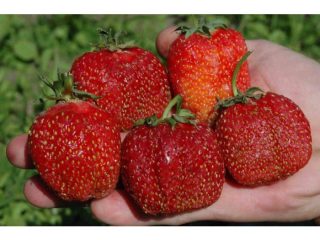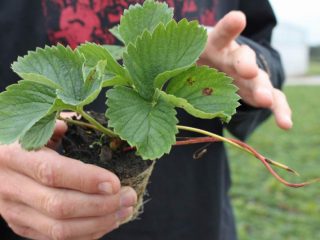Content
Strawberries are the favorite summer berry of all children and many adults. Growing strawberries is not at all difficult, the main thing is to regularly water the bushes, monitor their “health”, and, of course, apply fertilizers. Strawberries need to be fertilized several times a season, and the most important fertilizing is considered to be in the fall. You can’t expect a good harvest next year if you don’t prepare the bushes for winter.
What is it for? fertilizing strawberries in the fall, and what fertilizers need to be used so that the berries bear fruit better in the new season - there will be an article about this.
Why is autumn fertilizer for strawberries so important?
Strawberries contain a lot of useful substances and vitamins, they help strengthen the immune system and support the health of internal organs. Modern varieties of garden strawberries are characterized by high yields, and remontant varieties are even capable of bearing fruit all summer.
For such a yield, the soil under the berries must be saturated with all the necessary microelements - otherwise, where will all the “benefits” in the fruits come from? During the summer season, the gardener needs to fertilize his beds at least three times. One of these feedings occurs in the fall.
After a bountiful summer harvest, strawberries are weakened and need good nutrition to recover and prepare for the cold winter. It is during this period that buds are laid for the next season, so the plant must be healthy and strong.
Most often, gardeners fertilize garden strawberries in September, but much here depends on the variety of sweet berry. In any case, it is necessary to start feeding no earlier than the last berries have been removed from the bushes.
What fertilizers to use for strawberries in the fall
All gardeners know that fertilizers are divided into mineral, organic and mixed. At each stage of development, plants need different chemical components: for example, nitrogen is needed for green mass, and during the flowering period it is better to use superphosphate and potassium.
If you don’t feed the strawberries at all and don’t add fertilizer to the soil, good harvests will end very quickly - the natural composition of the soil will last for a couple of years at best. Regular fertilizing can increase berry yield by 20-30%, and remontant varieties without fertilizers will not bear fruit at all.
If strawberries have already yielded their harvest this season, they need one fertilizer composition, and when planting new plants in the fall, they should choose different fertilizers.
Organic fertilizers for strawberries
Most gardeners prefer to use organic fertilizers in the fall, since strawberries really love such compounds.After adding organic matter, the soil becomes loose, allows more air to pass through, and retains moisture well. And the garden strawberries themselves feel great: organic substances are quickly absorbed by plants and restore the strength of strawberries after the fruiting stage.
You can feed strawberries with any of the existing organic compounds, you just need to use them correctly:
- Cow dung It is forbidden to use it fresh to feed bushes, because as it decomposes, it gets very hot, which can harm the root system and even completely destroy the plants. Therefore, it is customary to prepare slurry by diluting a liter of manure in a bucket of water and infusing this composition in a warm place for several days. The result is a liquid with the consistency of store-bought sour cream, and pour it over the strawberries, being careful not to pour fertilizer on the roots and leaves.
- Cannot be used fresh bird droppings, since this is a very concentrated fertilizer that can completely burn all plantings. After fruiting and pruning the leaves, strawberries can be fed with an extract or a solution of chicken manure, only the fertilizer is poured between the rows and not under the bush.
- Leaf humus is one of the most successful fertilizers for strawberries; absolutely all plants love it. Humus collected from deciduous forests is especially good. This nutrient mixture is poured in a thick layer directly onto the strawberry beds, then the humus will also act as mulch and protect the strawberry leaves from the cold in winter.
- Compost You can also fertilize strawberries from food waste. It is important to prevent prohibited products and plant residues from the garden (both weeds and cultivated ones) from getting into the compost.Well-rotted compost is quite loose, it can perform the same task as humus. The bushes are simply covered with compost after pruning, and another handful of this composition is added to each hole when planting young bushes.
- Wood ash completely saturates strawberry bushes with phosphorus, so it is successfully used instead of superphosphate and similar mineral fertilizers. In the fall, after trimming the leaves, wood ash is evenly scattered over the area with strawberry bushes. Fertilizer consumption should not exceed 150 grams per square meter of garden.
- Green fertilizers have also proven themselves well - they are increasingly used to fertilize beds by those who do not have access to fresh organic matter (manure or droppings). For strawberries, you can use chopped lupine leaves, nettle infusion or planting green manure. Any mown grass can become fertilizer for garden strawberries; it is simply laid out between the beds and lightly sprinkled with soil.
Mineral fertilizers for garden strawberries
Not all gardeners and summer residents have access to fresh organic matter. The solution for such gardeners is mineral components, which can be purchased at any specialized store.
Mineral fertilizers are sold in the form of granules, powders or drops; they are convenient to work with and easy to calculate a safe dosage. But you need to be extremely careful, because an excess of mineral supplements is more dangerous than their deficiency.
Good options for strawberries when planting in the fall and for bushes that have already produced their harvest:
- watering the rows with a solution of potassium salt prepared in a proportion of 20 grams of salt per 10 liters of water.
- A composition of 10 grams of superphosphate diluted in a bucket of water will give the same effect. Just water the strawberries carefully, trying not to get them on the leaves and rosettes.
- A mixed composition of 2 tablespoons of nitrophoska, 20 grams of potassium salt and a bucket of water is used to water already trimmed bushes. A liter of this fertilizer is poured under each bush. After a couple of days, the ground under the strawberries needs to be mulched with sawdust, peat, pine needles or humus.
- At the beginning of September, it is recommended to use ready-made Kemira autumn fertilizer. It is diluted in water, using 50 grams of the drug per square meter of land.
Preparing for winter
As already mentioned, the choice of fertilizer depends on whether old bushes are fed or whether feeding is necessary after planting new plants. So, it is better to feed fruit-bearing plants twice: at the beginning of September and at the end of October.
You can use potassium humate or superphosphate for this. If the strawberries are just planting, then it is advisable to pour a handful of humus, compost or wood ash into each hole.
If you cover the beds with mulch immediately after applying fertilizer, you don’t have to fertilize until next fall - the protected roots will have enough fertilizer for the whole year.
Since the fall, they have been performing the following actions:
- continue to water the strawberry beds throughout September;
- they treat diseased bushes and fight pests - affected strawberries will definitely not survive the winter;
- cut the leaves with sharp pruners or scissors, being careful not to cut off the stems and rosettes, and also remove all the tendrils;
- loosen the soil between the rows and hill up the strawberry bushes;
- Cover the beds with covering material or dry leaves, spruce branches, and sawdust.
An integrated approach will help preserve most of the bushes and provide a good harvest of berries next year. It is necessary to fertilize strawberries in the fall, because the number of flowers and ovaries in the next season, as well as the taste and size of the berries, depends on this.



















